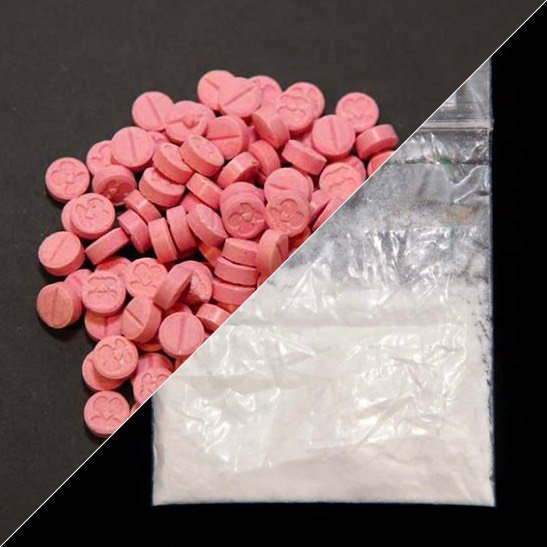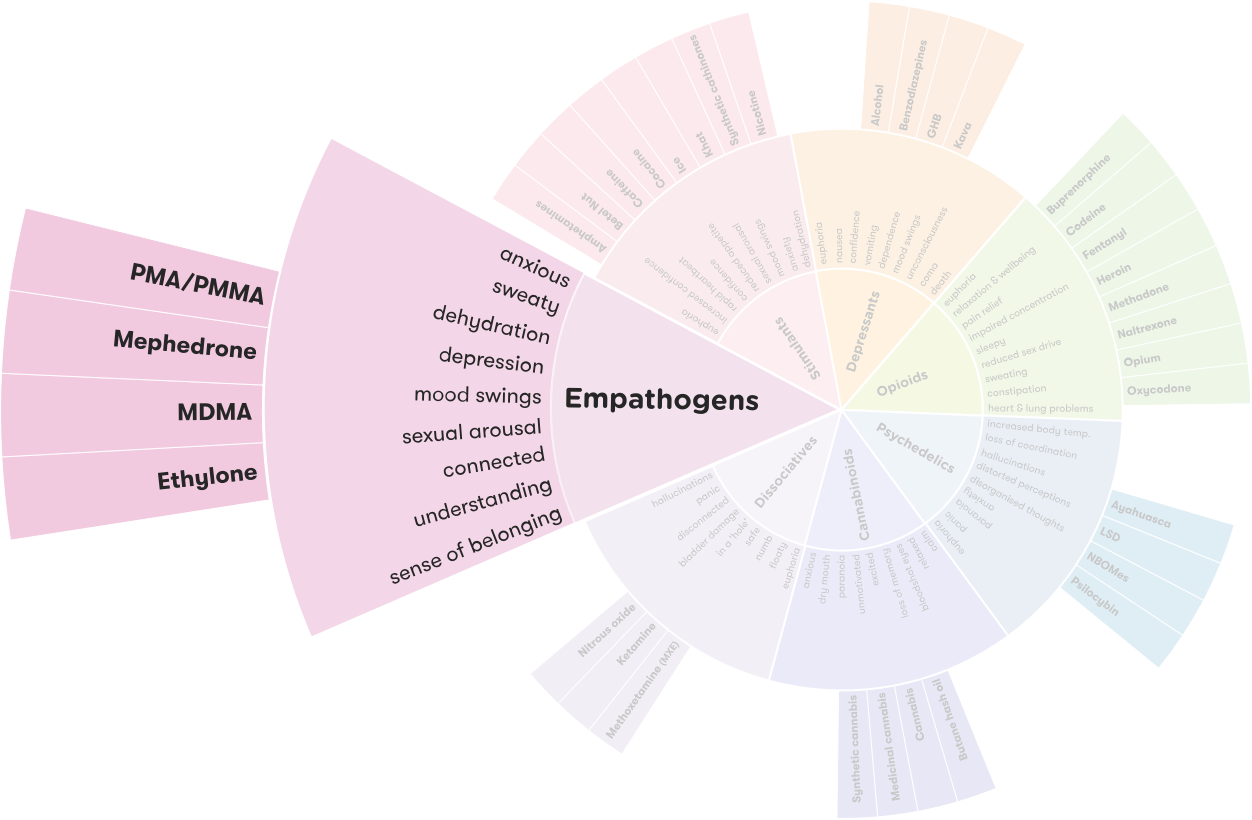Empathogens

Last published: June 06, 2024
What are empathogens?
Empathogens increase a person’s feeling of empathy and benevolence towards others, as well as feelings of being socially accepted and connected.1
They can increase friendliness and playfulness, but can also cause mood swings, dehydration and depression.2 Empathogens are sometimes referred to as entactogens.
Empathogens and the brain
Empathogens cause the release of dopamine and serotonin in the brain. Serotonin controls mood, appetite and sleep, and can make you feel relaxed.
Using empathogens can cause the serotonin levels in the brain to become very low, and can also lead to hyperthermia (over-heating).3
What do they look like?
Empathogens such as MDMA are usually found in pill, crystal or capsule forms.
They include:
- MDMA (ecstasy)
- MDA
- mephedrone
- ethylone.
How are they used?
They are usually swallowed, but can be snorted, injected or shelved (used rectally).
Commonly used empathogens
Explore empathogens on the Drug Wheel

Effects of empathogens
Use of any drug can have risks. It’s important to be careful when taking any type of drug.
Empathogens affect everyone differently, based on:
- size, weight and health
- whether the person is used to taking it
- whether other drugs are taken around the same time
- the amount taken
- the strength of the drug (varies from batch to batch)
- the environment (where the drug is taken).
Effects can include:
- feeling connected
- having a sense of belonging
- feeling warm
- sexual arousal
- becoming anxious
- sweating
- mood swings
- having energy
- depression
- dehydration.3, 4
Coming down
In the days after empathogen use, you may experience:
- restless sleep and exhaustion
- anxiety, irritability and depression
- paranoia (feeling extremely suspicious and frightened)
- difficulty concentrating.5-7
The use of depressant drugs such as alcohol, benzodiazepines or cannabis to help with these ‘come down’ effects may result in dependence on both types of drugs.
Impact of mood and environment
Drugs that affect a person’s mental state (psychoactive drugs) can also have varied effects depending on a person’s mood (often called the ‘set’) or the environment they are in (the ‘setting’).
Set: a person’s state of mind, previous encounters with empathogens, and expectations of what’s going to happen. For example, feelings of stress or anxiety before using empathogens may result in an unpleasant experience.8
Setting: the environment in which someone consumes empathogens – whether it’s known and familiar, who they’re with, if they’re indoors or outdoors, the type of music and light. For example, using empathogens in a calm, quiet and relaxed environment can lead to, or contribute to, a pleasant experience but being in a noisy, crowded place may result in a negative experience.8
Being in a good state of mind, with trusted friends and a safe environment, before taking empathogens reduces the risk of having a negative experience.
Mixing empathogens with other drugs
Using empathogens with other drugs can be dangerous. In particular, with other drugs that increase the amount of serotonin in the brain, including antidepressants, SSRIs, L-Tryptophan and other empathogens.9
High levels of serotonin can lead to serotonin toxicity or serotonin syndrome. This is a serious condition with symptoms such as confusion, agitation, sweating, increased heart rate and muscle spasms, and can be fatal.10
More on Polydrug use
Polydrug use is a term for the use of more than one drug or type of drug at the same time or one after another. Polydrug use can involve both illicit drugs and legal substances, such as alcohol and medications.
Reducing harm
Use of empathogens is likely to be more dangerous when:
- taken in combination with alcohol or other drugs.
- driving or operating machinery as a person’s ability to judge distance and space is extremely limited
- used in an unsafe environment. It is best to use in a safe environment where you feel comfortable and with people you trust
- used in large doses or repeatedly
- alone (in case medical assistance is required)
- engaged in vigorous or energetic activities such as dancing
- the person has a mental health problem.12
Often drugs sold as ecstasy may not actually contain any of the chemical MDMA. They can be a mix of amphetamine, paramethoxyamphetamine (PMA), ketamine, NBOMe, methylone or other substances.
Dependence and tolerance
Regularly using empathogens can build up a tolerance in your body, and you need to take a larger amount to feel the same effect.
Using empathogens on a regular basis may mean that you are releasing and depleting serotonin before it has had a chance to build back up. Experiencing low serotonin levels can lead to depression and depressive symptoms.13
Getting help
If your use of empathogens is affecting your health, family, relationships, work, school, financial or other life situations, or you’re concerned about a loved one, you can find help and support.
Call the National Alcohol and Other Drug Hotline on 1800 250 015 for free and confidential advice, information and counselling about alcohol and other drugs
Help and Support Services search
Find a service in your local area from our list. Simply add your location or postcode and filter by service type to quickly discover help near you.
If you're looking for other information or support options, send us an email at druginfo@adf.org.au
Path2Help
Not sure what you are looking for? Try our intuitive Path2Help tool and be matched with support information and services tailored to you.
Find out more
Empathogens and the law
Federal and state laws provide penalties for possessing, using, making, importing, selling or driving under the influence of empathogenic drugs such as MDMA.
- European Monitoring Centre for Drugs and Drug Addiction. Drug profiles: glossary Empathogens 2018 [cited: 23.06.2022].
- Week B. "MDMA: Empathogen or love potion?": Gale Academic OneFile; 2010 [21.04.2021].
- Mark Adley. Drugs and the Brain A Beginner’s Guide to Stimulants and Empathogens 2014 [cited: 05.04.2022].
- UK Drugwatch. The Drugs Wheel 2019 [cited: 05.04.2022].
- Campbell A. The Australian Illicit Drug Guide. Melbourne: Black Inc; 2001.
- Brands B Sproule B Marshman J. Drugs & Drug Abuse. 3rd ed. Ontario: Addiction Research Foundation; 1998.
- McKetin R Copeland J Norberg M Bruno R Hides L Khawarb L. The effect of the ecstasy ‘come-down’ on the diagnosis of ecstasy dependence. Drug and Alcohol Dependence. 2014;139.
- Nutt D. Drugs without the hot air : making sense of legal and illegal drugs. Cambridge: UIT Cambridge Ltd; 2012.
- Scotton W Hill L Williams A Barnes N. Serotonin Syndrome: Pathophysiology, Clinical Features, Management, and Potential Future Directions. International Journal of Tryptophan Research 2019;12.
- Dobry Y Rice T Sher L. Ecstasy use and serotonin syndrome: a neglected danger to adolescents and young adults prescribed selective serotonin reuptake inhibitors. Internationa Journal of adolescent medicine and health 2013;25(3).
- World Health Organization. Lexicon of alcohol and drug terms 2021 [19.03.2021].
- Davis A Rosenberg H. Specific harm reduction strategies employed by 3,4-methylenedioxymethamphetmine/ ecstasy users in the United States and the United Kingdom. Drug Science, Policy and Law 2017;3.
- In-Hei Hahn. MDMA Toxicity 2021 [cited: 06.04.2022].